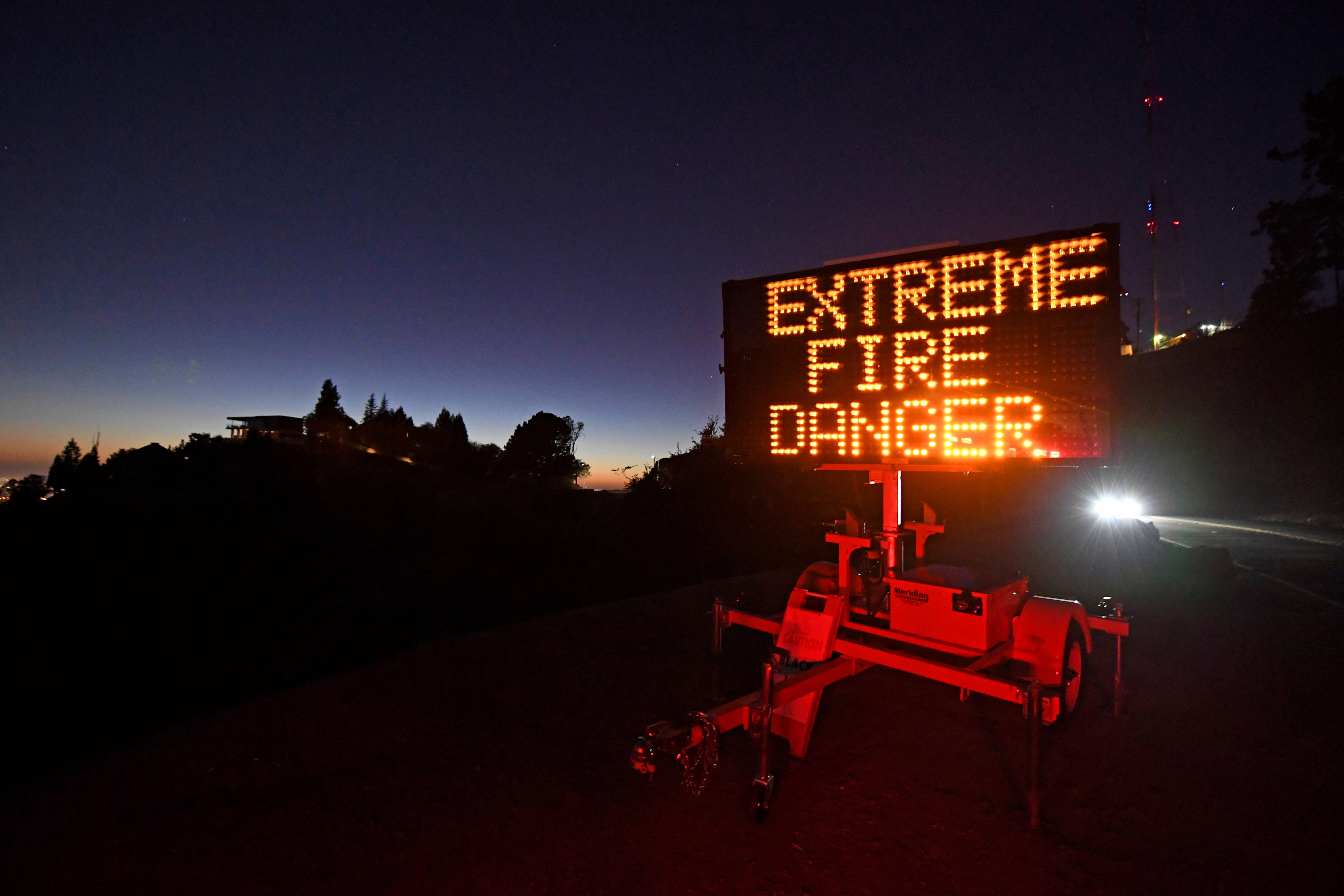Power shut off in California as winds, fire danger increase
Large swaths of California were without power Monday as utilities sought to prevent the chance of their equipment sparking wildfires while the fire-weary state was buffeted by powerful winds and dangerously dry weather conditions

Your support helps us to tell the story
From reproductive rights to climate change to Big Tech, The Independent is on the ground when the story is developing. Whether it's investigating the financials of Elon Musk's pro-Trump PAC or producing our latest documentary, 'The A Word', which shines a light on the American women fighting for reproductive rights, we know how important it is to parse out the facts from the messaging.
At such a critical moment in US history, we need reporters on the ground. Your donation allows us to keep sending journalists to speak to both sides of the story.
The Independent is trusted by Americans across the entire political spectrum. And unlike many other quality news outlets, we choose not to lock Americans out of our reporting and analysis with paywalls. We believe quality journalism should be available to everyone, paid for by those who can afford it.
Your support makes all the difference.Large swaths of California were without power Monday as utilities sought to prevent the chance of their equipment sparking wildfires while the fire-weary state was buffeted by powerful winds and dangerously dry weather conditions.
More than 1 million people were expected to be in the dark during what officials have said could be the strongest wind event in California this year.
North of San Francisco, a weather station on Mount St. Helena recorded a hurricane-force gust of 89 mph (143 kph) late Sunday and sustained winds of 76 mph (122 kph). By early Monday winds had calmed slightly, while still topping 60 mph (97 kph), the National Weather Service said.
“While this is less than what we saw earlier, these winds are still strong and dry conditions prevail,” the agency said on Twitter.
At lower elevations, gusts reached 50 mph (80 kph) early Monday across the San Francisco Bay Area, where tens of thousands had their electricity turned off. Officials extended a red flag warning through 5 p.m. Tuesday for East and North Bay mountain areas.
It’s the fifth time this year that Pacific Gas & Electric, the nation’s largest utility, has cut power to customers in a bid to reduce the risk that downed or fouled power lines or other equipment could ignite a blaze during bone-dry weather conditions and gusty winds. On Sunday, the utility shut off power to 225,000 customers in Northern California and later did the same for another 136,000 customers in a total of 36 counties.
“This event is by far the largest we’ve experienced this year, the most extreme weather,” said Aaron Johnson, the utility’s vice president of wildfire safety and public engagement. “We’re trying to find ways to make the events less difficult.”
Crews were able to quickly contain small fires that broke out Sunday in Sonoma and Shasta counties. The causes were under investigation.
The National Weather Service issued red flag warnings for much of the state, predicting winds of up to 35 mph (56 kph) in lower elevations and more than 70 mph (113 kph) in mountainous areas of Southern California. The concern is that any spark could be blown into flames sweeping through tinder-dry brush and forestland.
The conditions could equal those during devastating fires in California’s wine country in 2017 and last year’s Kincade Fire, the National Weather Service said. Fire officials said PG&E transmission lines sparked that Sonoma County fire last October, which destroyed hundreds of homes and caused nearly 100,000 people to flee.
Weather conditions shifted in Northern California on Sunday, with humidity dropping and winds picking up speed, said Scott Strenfel, senior meteorologist for PG&E. He said another round of winds is expected Monday night.
Southern California, which saw cooler temperatures and patchy drizzle over the weekend, saw extreme fire weather move in late Sunday. Southern California Edison said it was considering safety outages for 71,000 customers in six counties starting Monday, with San Bernardino County potentially the most affected.
Los Angeles County urged residents to sign up for emergency notifications and prepare to evacuate, preferably arranging to stay with family or friends in less risky areas who aren’t suspected to have the coronavirus. Local fire officials boosted staffing as a precaution.
“The reality is come midnight and through Tuesday we’re going to be in the most significant red flag conditions we’ve had this year,” said Kevin McGowan, director of the county’s Office of Emergency Management.
Scientists say climate change has made California much drier, meaning trees and other plants are more flammable. Traditionally October and November are the worst months for fires, but already this year the state has seen more than 8,600 wildfires that have scorched a record 6,400 square miles (16,576 square kilometers) and destroyed about 9,200 homes, businesses and other structures. There have been 31 deaths.
Many of this year’s devastating fires were started by thousands of dry lightning strikes, but some remain under investigation for potential electrical causes. While the biggest fires in California have been fully or significantly contained, more than 5,000 firefighters remain committed to 20 blazes, including a dozen major incidents, state fire officials said.
PG&E officials said the planned outages are a safety measure and understood they burden residents, especially with many working from home and their children taking classes online because of the coronavirus pandemic.
Sheriff Kory Honea of Butte County said he’s concerned about residents in foothill communities during the blackouts because cellular service can be spotty and it’s the only way many can stay informed when the power is out.
“It is quite a strain on them to have to go through these over and over and over again,” he said.
___
Taxin reported from Orange County, California. Associated Press writer Christopher Weber in Los Angeles contributed to this report.